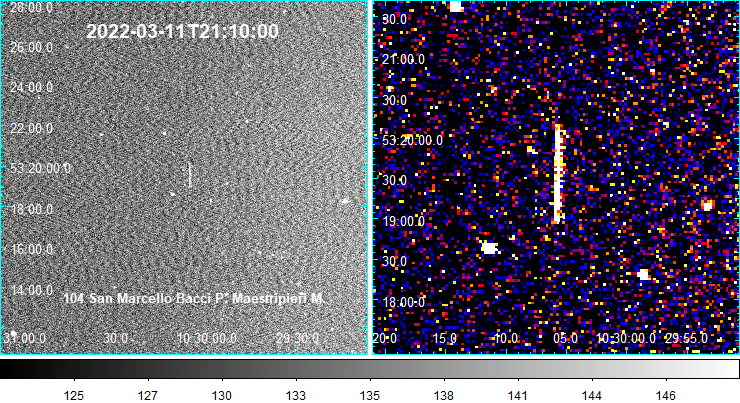Last week, a small asteroid was detected just two hours before it impacted Earth’s atmosphere. Luckily, it was only about 3 meters (10 feet) wide, and the space rock, now known as 2022 EB5 likely burned up in Earth’s atmosphere near Iceland at 21:22 UTC on March 11.
While it is wonderful that astronomers can detect asteroids of that size heading towards our planet — as well as determine the asteroid’s trajectory and precisely predicted its impact location — the last-minute nature of the discovery definitely causes a pause. What if it had been bigger?
While every day, Earth gets bombarded with more than 100 tons of dust and sand-sized particles, those objects never reach the ground – they only give us spectacular ‘shooting stars’ or meteor showers we can safely enjoy.
NASA says about once a year, an asteroid about the size of 2022 EB5 (approximately the size of a car) hits Earth’s atmosphere, creates a really impressive fireball, and burns up before reaching the surface. Any asteroids smaller than about 20 meters (about 65 feet) will most likely burn up as they enter the Earth’s atmosphere. If any portion of it does survive, it would be in smaller meteorites that cause little or no damage. But not always.

The Chelyabinsk meteor, which broke up over Russia in 2013, was approximately 20 meters (65 feet) across, or the size of a six-story building. Barreling through the atmosphere, it unleashed an intense shock wave that shattered windows and collapsed buildings, leaving about 1,200 people injured.
If a rocky meteoroid larger than 25 meters (82 feet) but smaller than one kilometer (a little more than 1/2 mile) were to hit Earth, it would likely cause local damage to the impact area.
Anything larger could cause significant damage. NASA estimates that every 2,000 years or so, a meteoroid the size of a football (300 feet, 100 meters) field hits Earth. In 2019, there was a close-call, where Asteroid 2019 OK – which was an estimated 57 to 130 meters wide (187 to 427 feet), was detected just hours before it made a close pass by Earth, coming within about 73,000 kilometers (45,000 miles). That’s less than one-fifth of the distance to the Moon and is considered uncomfortably close. If an asteroid that size hit Earth, it could wipe out an entire city.
In the case of the recent small asteroid discovery, Hungarian astronomer Krisztián Sárneczky at the Konkoly Observatory near Budapest spied the car-sized 2022 EB5 on March 11, 2022, just two hours before it hit Earth’s atmosphere. Why so late?
As of now, astronomers primarily rely on ground-based observatories to detect asteroids. Small, dark space rocks are difficult to see, since they need to reflect sunlight in order to be visible. Additionally, any object that has an eccentric orbit or that has the Sun blocking its view as it comes toward us are hard to see from Earth.
Earlier this year, NASA announced the Asteroid Terrestrial-impact Last Alert System (ATLAS) had become the first survey capable of searching the entire dark sky every 24 hours for near-Earth objects. The system is comprised of four telescopes, two in the northern hemisphere telescopes on Haleakala and Maunaloa in Hawai’i, and two additional observatories in South Africa and Chile. This all-sky survey joins other networks of observatories that search the skies, including JPL’s Near Earth Object program, the Catalina Sky Survey and PAN-STARRS.

But astronomers know that dedicated space telescopes are needed to track incoming asteroids and comets. The WISE mission, originally an infrared-wavelength astronomical space telescope that launched in 2009, was reassigned a new mission after its coolant was depleted. In 2013 the spacecraft became NEOWISE, with the goal of helping identify and describe near-Earth objects (NEOs). As of March 2021, the mission had made 1,130,000 confirmed infrared observations of approximately 39,100 objects throughout the solar system.
The Near-Earth Object Surveyor space telescope (NEO Surveyor) should be ready to launch by 2026. This mission will be capable of detecting both bright and dark asteroids, and should be able to find at least two-thirds of the near-Earth objects larger than 140 meters (460 feet). There are also plans in the works to attempt to deflect asteroids on a potential collision course with Earth, and the launch of NASA’s DART mission in November 2021 will test technology and help shed light on how to best deflect asteroids threatening our planet.

Lead image caption: 2022 EB5 captured by Paolo Bacci and Martina Maestripieri from at 21h 10min UT, which is 12 minutes before it entered the atmosphere, while it was only 12 300 km form Earth and its apparent speed close to 65?/sec. Credit: P. Bacci, M. Maestripieri

